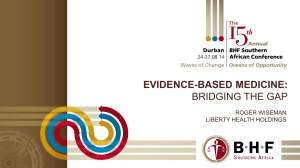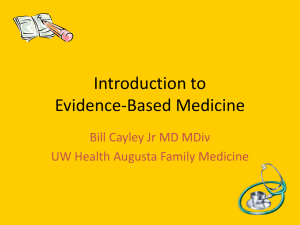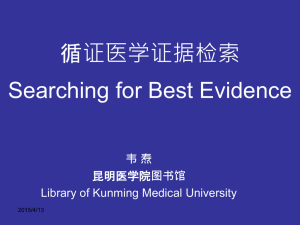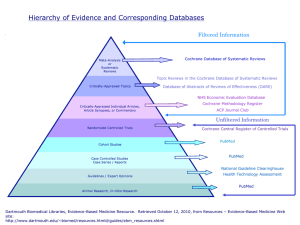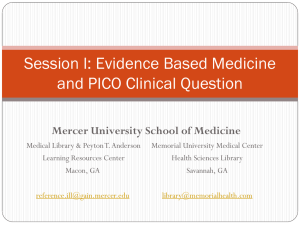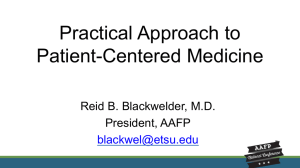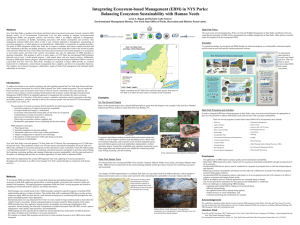Implementing Cochrane evidence via EBM Guidelines and EBMeDS
advertisement
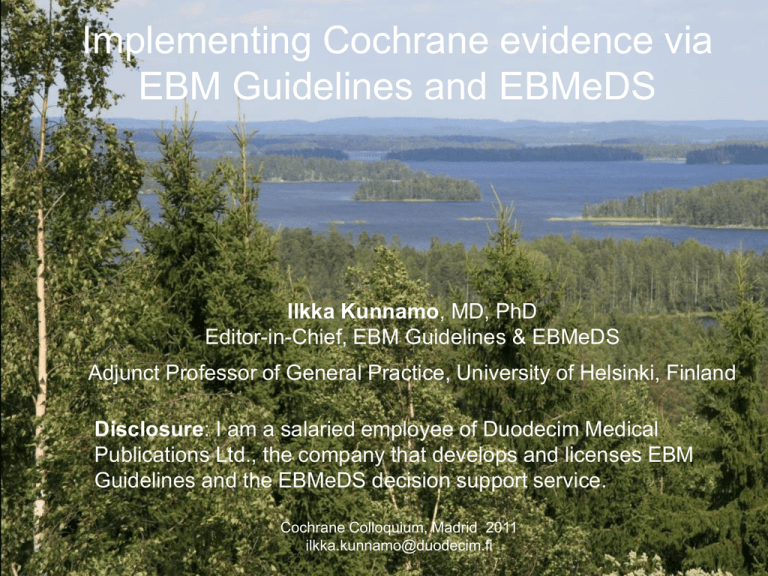
Implementing Cochrane evidence via EBM Guidelines and EBMeDS Ilkka Kunnamo, MD, PhD Editor-in-Chief, EBM Guidelines & EBMeDS Adjunct Professor of General Practice, University of Helsinki, Finland Disclosure: I am a salaried employee of Duodecim Medical Publications Ltd., the company that develops and licenses EBM Guidelines and the EBMeDS decision support service. Cochrane Colloquium, Madrid 2011 ilkka.kunnamo@duodecim.fi The Finnish Medical Society Duodecim • Scientific society founded in 1881 > 90% of the Finnish physicians as members • Clinical Practice Guidelines • Continuous Medical Education • Medical terminology in Finnish language • Awards and grants for young scientists Duodecim Medical Publications Ltd. • 100% owned by the Finnish Medical Society • Electronic publishing since 1989 • Publisher of the national health portal for both professionals and citizens in Finland History and production of EBM Guidelines • • • • • • • • Idea emerged Pilot electronic version on floppy disks CD-ROM Book Liaison with the Cochrane Collaboration Internet Mobile Computerized clinical decision support rules (EBMeDS) 1987 1989 1991 1992 2000 2000 2001 2008 • Translations in English, German, Russian, Estonian, Hungarian, Slovenian, Dutch, French Demo Included in Essential Evidence Plus Objective of EBM Guidelines • The right information • by one search term • within one minute Use of electronic guideline databases in Finland from the professionals’ portal 14000000 12000000 10000000 1.7 guidelines opened per every working-aged physician every day 8000000 6000000 4000000 2000000 0 2000 2001 2002 2003 2004 2005 2006 2007 2008 Number of guideline documents opened >12 million/year Using Cochrane evidence in EBM Guidelines • Evidence summaries are written by salaried physician editors from all Cochrane reviews that are relevant to the topics of EBM Guidelines • 2765 Cochrane reviews are cited in EBM Guidelines evidence summaries by 9/2011 EBM Guidelines uses a slightly modified GRADE system Evidence statement on patientimportant outcomes Reasons for downgrading Recommendation Link to Cochrane review Reason for weak recommendation (value statement) Standard wording for evidence and recommendations • The evidence summaries use standard wording for evidence and recommendations • See www.ebm-guidelines.com/dtk/ebm01066 Updating • Evidence-driven – Continuous scanning of the literature – When new important evidence is published, evidence summaries and recommendations are updated • Both scheduled (every 2 – 3 years) and (interim) continuous updates • The salaried Editorial Team is responsible for initiating the updates Salaried personnel for guideline development in Finland (excluding nursing and dentistry) • Physician editors 20 – Mostly part-time • • • • • Technical editors Informaticians IT professionals Secretaries Marketing and training 6 2 5 3 3 Monitoring the use of guidelines • Log files of on-line use • User surveys Databases accessed in 2010 by health care professionals (Finland) • • • • • EBM Guidelines Images and videos Patient information Evidence summaries Calculators (e.g. GFR) • Journal articles 5 046 070 1 852 327 1 264 010 226 954 225 562 1 271 714 Supplementary contents and tools that facilitate implementation are valued by users The most frequently opened documents in 2010 • • • • • • • • • GFR calculator Urinary tract infections PEF calculator Lyme borreliosis Fungal infections of skin and nails Diabetes Medical requirements for driving license Erysipelas Hypothyroidism 60728 46470 31199 31012 29195 28204 26818 26028 25752 The most frequently used search terms in 2010 (translated from Finnish) • • • • • • • • • Diabetes Urinary tract infection Asthma Gfr Pneumonia Gout Hypertension Anaemia Sinusitis 47636 41994 38560 31429 27161 26933 23618 22727 22479 Ratio of opened guidelines and evidence summaries • EBM Guidelines Finnish version • EBM Guidelines German language version • Finnish national Current Care Guidelines via professionals’ portal • Finnish national Current Care Guidelines via Current Care website • EBM Guidelines English language version 93.7 19.3 4.0 The ratio reflects the context of use: only guidelines are opened during patient encounters; evidence summaries are opened during learning (CME) and preparation of presentations 1.3 1.1 Answers German-speaking countries vs. Finland Clinical decision support (CDS) • Recommendations in the form of CDS rules trigger reminders automatically if patient data suggest that there is potential for improvement. • Example: The patient has asthma and is using a nonselective beta-blocker – switch to selective beta-blocker The EBMeDS decision support service can be integrated with any electronic health record via XML messaging (see www.ebmeds.org) Electronic Health Record Knowledge resources EBMeDS Sends patient data (XML request message) Receives decision support (XML response message) Peter Nyberg Example of decision support and quality reporting for a population of 16 000 (a virtual health check) • Cardioselective beta-blockers for patients with asthma: No reminder (selective beta-blocker in use) 32 Reminder: Asthma – switch to selective beta-blocker? 4 Guideline compliance = 0.89 (n = 36) 89% of patients with asthma and beta-blocker used the right type of beta-blocker. What can be shared internationally (in addition to full guidelines) • • • • • Evidence summaries Instructions on how to perform procedures Images, videos Patient information Decision support tools • Guideline authoring and publishing software

